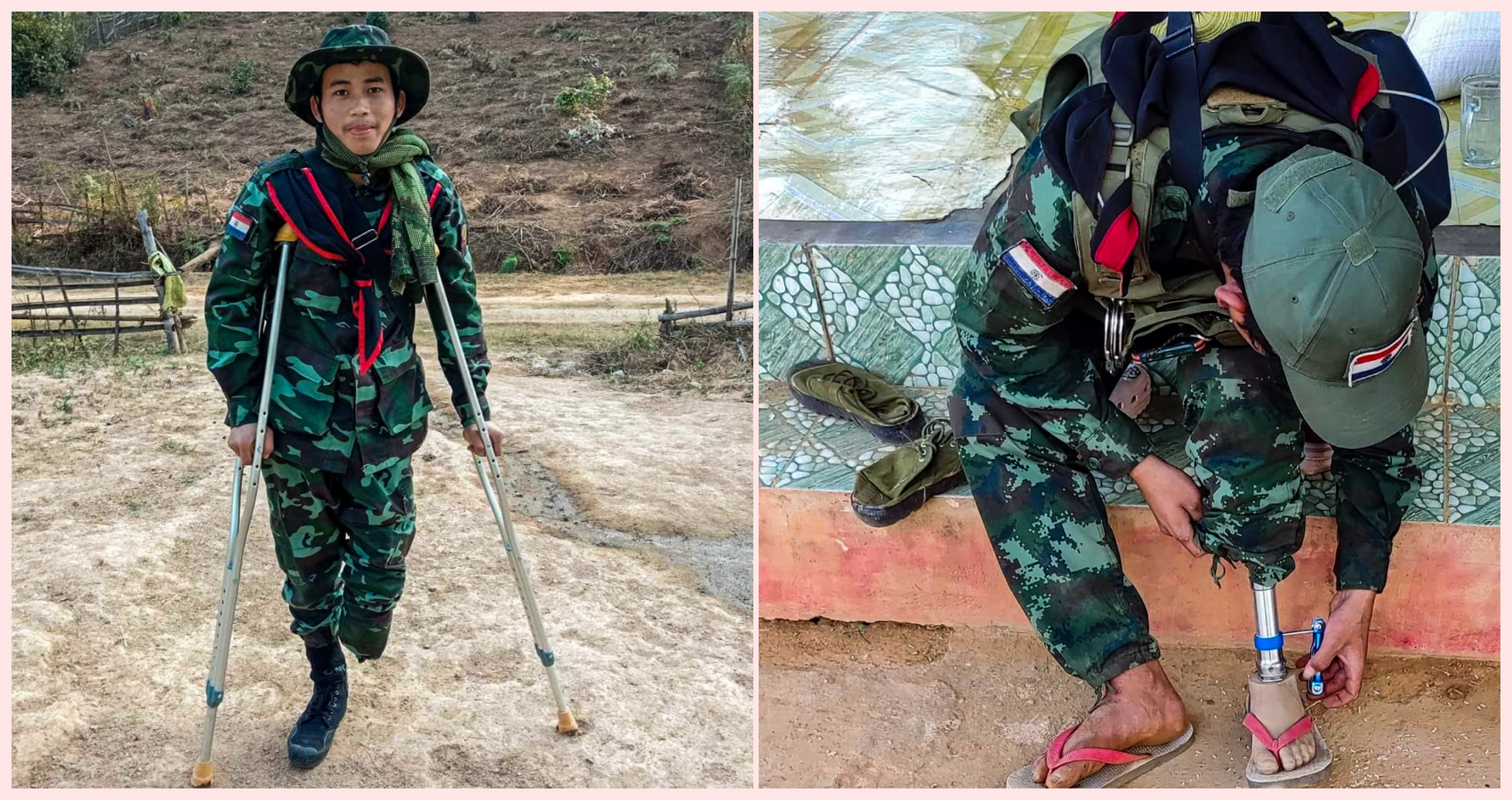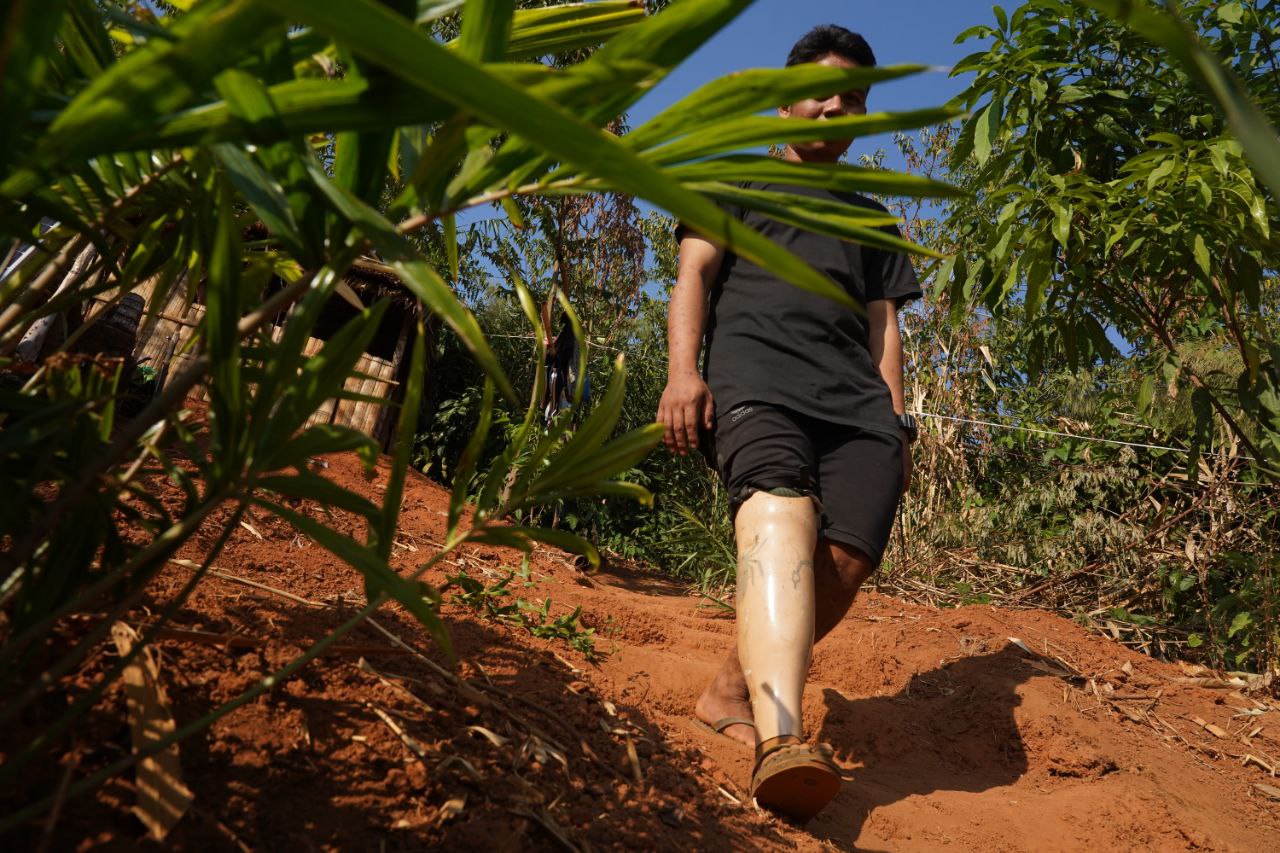‘Just Keep Fighting’: Myanmar’s Disabled Resistance Heroes Share Their Stories
06 February 2024

Exactly two years ago, 19-year-old Karenni resistance fighter Khu Me Reh suffered a life-changing ordeal while attempting to save a comrade who had stepped on a landmine on the frontline in Sanpya 6th Mile village, Demoso Township.
Known as a killing field, the area is riddled with landmines planted by the junta to target civilians and resistance fighters.
Taking a huge risk, Me Reh carefully approached his comrade to defuse the landmine and save his life. Unfortunately, he stepped on another landmine, triggering an explosion that injured both men severely and saw each lose a leg.
“I didn’t feel sad about losing my leg. I was just afraid of not being able to continue fighting against them [junta troops],” Me Reh recalled.
The native of Demoso Township never imagined himself on the frontline of a war before the coup. Working as a laborer making edible oil, Me Reh’s life was simple.
However, after the military overthrew the elected government in February 2021, he joined anti-coup demonstrations. The junta’s lethal crackdown on peaceful protesters led him, like many other youths, to take up arms.
Explaining his decision to become a resistance fighter with the Karenni Nationalities Defense Force, Me Reh said he realized the junta couldn’t be persuaded, so he decided to fight against it to liberate the people.

Khu Me Reh stands with the aid of crutches in a Karenni jungle before being fitted with a prosthesis in 2022.
With that conviction, he has never hesitated to fight junta troops in every encounter and clash.
Even losing his leg didn’t deter him from participating in the revolution to oust the dictatorship. Soon after completing his rehabilitation, he rejoined his comrades on the frontline.
However, it had taken six months to recover and adjust to his prosthesis.
“I worked hard at the exercises with the prosthesis so I could get back to the frontlines as soon as possible,” he said.
He felt intense pain in his leg bones during the early months of recovery but spurred himself not to give up and keep fighting for his ambition to drive out the dictatorship.
He said the encouragement he received from resistance colleagues was invaluable in overcoming the challenges he faced during recovery.
“I would urge others who have become disabled in this revolution to keep fighting! We are going to achieve the goal we all want,” he said.
Khu Me Reh is not alone. Numerous young people have returned to the frontline or other revolutionary duties with resistance groups after suffering life-changing injuries in the struggle.
In KNDF Battalion 9, where Khu Me Reh serves, at least 10 fighters have lost limbs in the line of duty. Eight of them continue to participate in the revolution either on the frontline or in support roles.
The parallel National Unity Government (NUG) estimates that 300 to 500 People’s Defense Force (PDF) fighters have been disabled in clashes with the junta forces or fashioning homemade explosives. That estimate does not cover local defense forces (LPDFs) or ethnic armies such as the KNDF.
Ko Aung Paing was in his first year of university in Yangon when joined the resistance soon after the 2021 coup.

Aung Paing walks down a slope at Bamar People’s Liberation Army headquarters in 2023.
“My mother and I voted in the 2020 general election but the military annulled the result and seized power, which I felt was unjust,” said Aung Paing, who voted for the first time.
In a brutal crackdown on a peaceful protest in May 2021, he was arrested and detained overnight but released as he was underaged at the time.
His single mother, who raised him alone, didn’t want him to continue in the anti-regime movement. But the tears of his loving parent couldn’t extinguish the blaze burning in his heart for the innocent people being oppressed and killed by the junta.
Aung Paing became an officer in the Bamar People’s Liberation Army (BPLA). He lost his right leg in January 2022, after stepping on a junta landmine while building bunkers in Karen State during a combined operation with the Karen National Liberation Army (KNLA), the armed wing of the Karen National Union (KNU).
He had to receive treatment at KNU clinics for several months. It took almost a year before he had recovered enough to take up his crucial role behind the lines at BPLA headquarters.
He was often depressed during his long period of medical treatment and rehabilitation. But he never lost sight of his goal – to uproot military dictatorship from the country.
He returned to the BPLA as head of the Political Commissar’s Office, where his duties include teaching new recruits military skills, as well as the principles of federalism and democracy.
Having initially taken up arms against the junta, it was a great loss when he was unable to return to the front lines due to the condition of his leg. He gets depressed about it sometimes. But he is encouraged by the thought that his new role is also crucial.
“In this revolution, our work is not just about annihilating junta troops. We cannot succeed just by killing them. We also need to eradicate the wrong ideas and thoughts that the system [dictatorship] has instilled in our society for decades,” Aung Paing said.
Along with Ko Aung Paing and Khu Me Reh, many other disabled fighters are participating in the revolution in every resistance group.
In some groups, there are even leaders who have become disabled after suffering severe wounds in clashes with junta forces.
Captain Manar Lain Aung, deputy chief commander of Chin Defense Force (Mindat), has had part of his spleen removed and short leg bones replaced by steel appliances, but he continues to participate in the armed resistance, explained Za Latt Thway, a CDF Mindat communications officer.
Za Latt Thway, 30, was a famous champion in Lethwei, or traditional Myanmar boxing, with a dream to return to the ring once the revolution had succeeded.

Za Latt Thway, a former champion boxer, will not return to the ring again after his arm was severely injured in a battle with junta troops.
However, his right arm was severely injured after being hit by bullets in a clash with junta troops. Though he can still pull the trigger of his gun, it is impossible for him to fight in a professional boxing ring.
At least 20 of his comrades have lost limbs, but they continue to participate in the revolution either on the frontlines or at the rear.
Along with existing ethnic armed organizations (EAOs), new armed resistance groups formed since the coup face the challenges of providing healthcare services for severely injured members. These challenges arise at every step, from amputation to treatment to providing prosthetic limbs or appliances.
“It’s sad. They are youths, especially Generation Z, who should be in classrooms, university campuses, libraries or workplaces. Instead, they have been forced onto the path of armed struggle after the military staged the coup,” said an official from the NUG’s Ministry of Defense (MOD).
The rehabilitation branch of the MOD’s People’s Security Department is tasked with caring for these disabled fighters.
“We still need more support in providing prostheses, and after providing them, we need other equipment and professionals to train the injured fighters to become accustomed to these appliances in their daily lives,” said the MOD official.
Additionally, Rehabilitation Centers need to be established closer to areas with PDF battalions throughout the country, allowing fighters who lose limbs to stay and receive training with prosthetic appliances.
However, what Khu Me Reh, Ko Aung Paing and Za Latt Thway want is public support for the revolution.
Khu Me Reh said that if the revolution ends successfully, he wants to live peacefully with his family, making a living from traditional agriculture in rural Karenni.
“We have almost achieved our goal. I just want the people to keep supporting us in our need for arms and ammunition so we can end this as soon as possible,” he said.
“I will just keep fighting until we win in this revolution.”
Announcements
28 February 2025
Asian NGO Network on National Human Rights Institutions , CSO Working Group on Independent National Human Rights Institution (Burma/Myanmar)
Open letter: Removal of the membership of the dis-accredited Myanmar National Human Rights Commission from the Southeast Asia National Human Rights Institution Forum

Progressive Voice is a participatory rights-based policy research and advocacy organization rooted in civil society, that maintains strong networks and relationships with grassroots organizations and community-based organizations throughout Myanmar. It acts as a bridge to the international community and international policymakers by amplifying voices from the ground, and advocating for a rights-based policy narrative.